PONTIAC FIERO 1988 Service Repair Manual
Manufacturer: PONTIAC, Model Year: 1988, Model line: FIERO, Model: PONTIAC FIERO 1988Pages: 1825, PDF Size: 99.44 MB
Page 521 of 1825
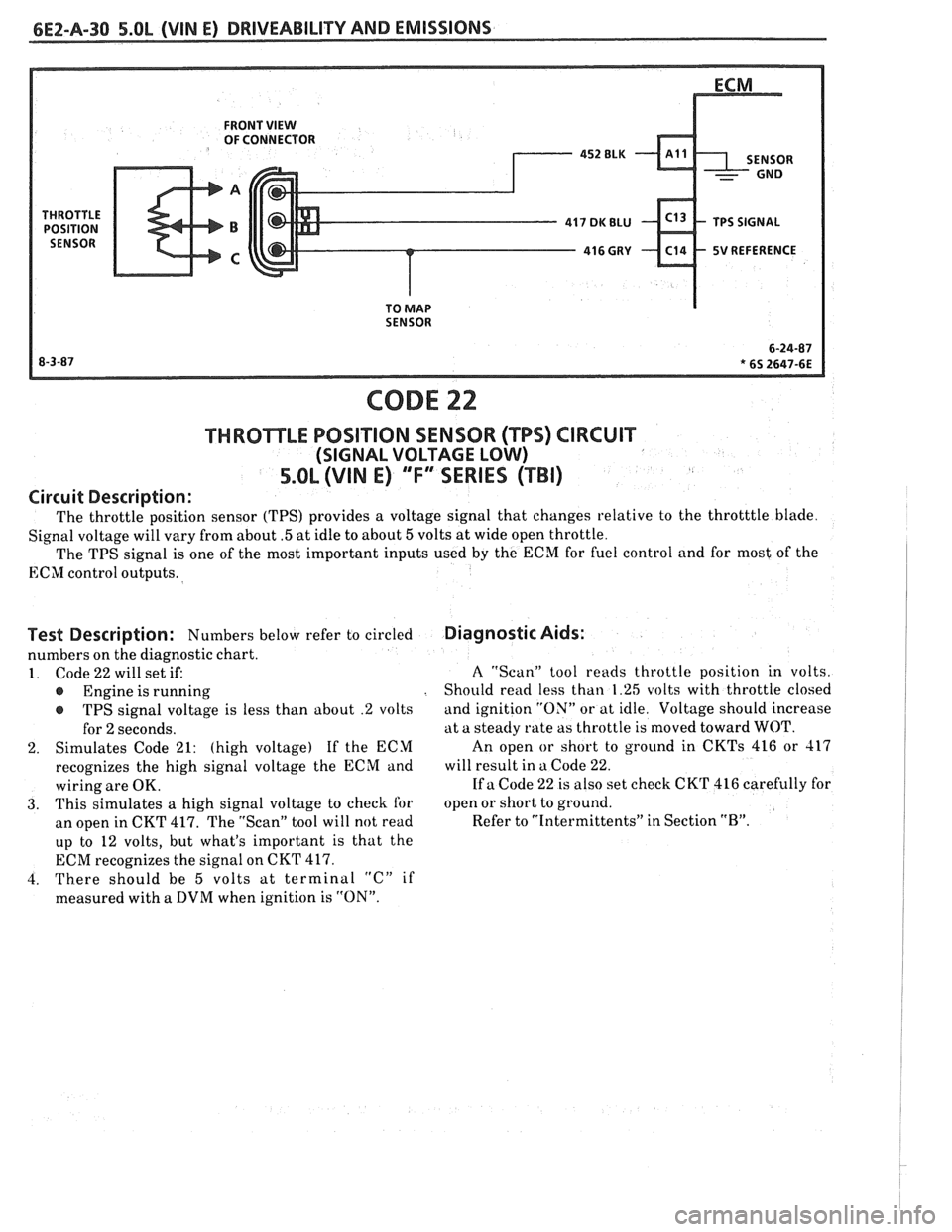
FRONT VIEW OF CONNECTOR
5V REFERENCE
SENSOR
CODE 22
THROTTLE POSITION SENSOR (TPS) CIRCUIT
(SIGNAL VOLTAGE LOW)
5.OL (VIN E) "'F3ERIES (TBI)
Circuit Description:
The throttle position sensor (TPS) provides a voltage signal that changes relative to the throtttle blade.
Signal voltage will vary from about
.5 at idle to about 5 volts at wide open throttle.
The TPS signal is one of the most important inputs used
by the ECM for fuel control and for most of the
ECM control outputs.
Test Description: Numbers below refer to circled
numbers on the diagnostic chart.
1. Code 22 will set if:
Engine is running
r TPS signal voltage is less than about .2 volts
for
2 seconds.
2. Simulates Code 21: (high voltage) If the ECM
recognizes the high signal voltage the ECM and
wiring are OK.
3. This simulates a high signal voltage to check for
an open in CKT 417. The "Scan" tool will not read
up to 12 volts, but what's important is that the
ECM recognizes the signal on CKT 417.
4. There should be
5 volts at terminal "C" if
measured with a DVM when ignition is "ON".
Diagnostic Aids:
A "Scan" tool reads throttle position in volts.
Should read less than 1.25 volts with throttle closed
and ignition "ON" or at idle. Voltage should increase
at a steady rate as throttle is moved toward WOT.
An open
or short to ground in CKTs 416 or 417
will result in a Code 22.
If a Code 22 is also set check CKT 416 carefully for
open or short to ground.
Refer to "Intermittents" in Section
"B".
Page 522 of 1825
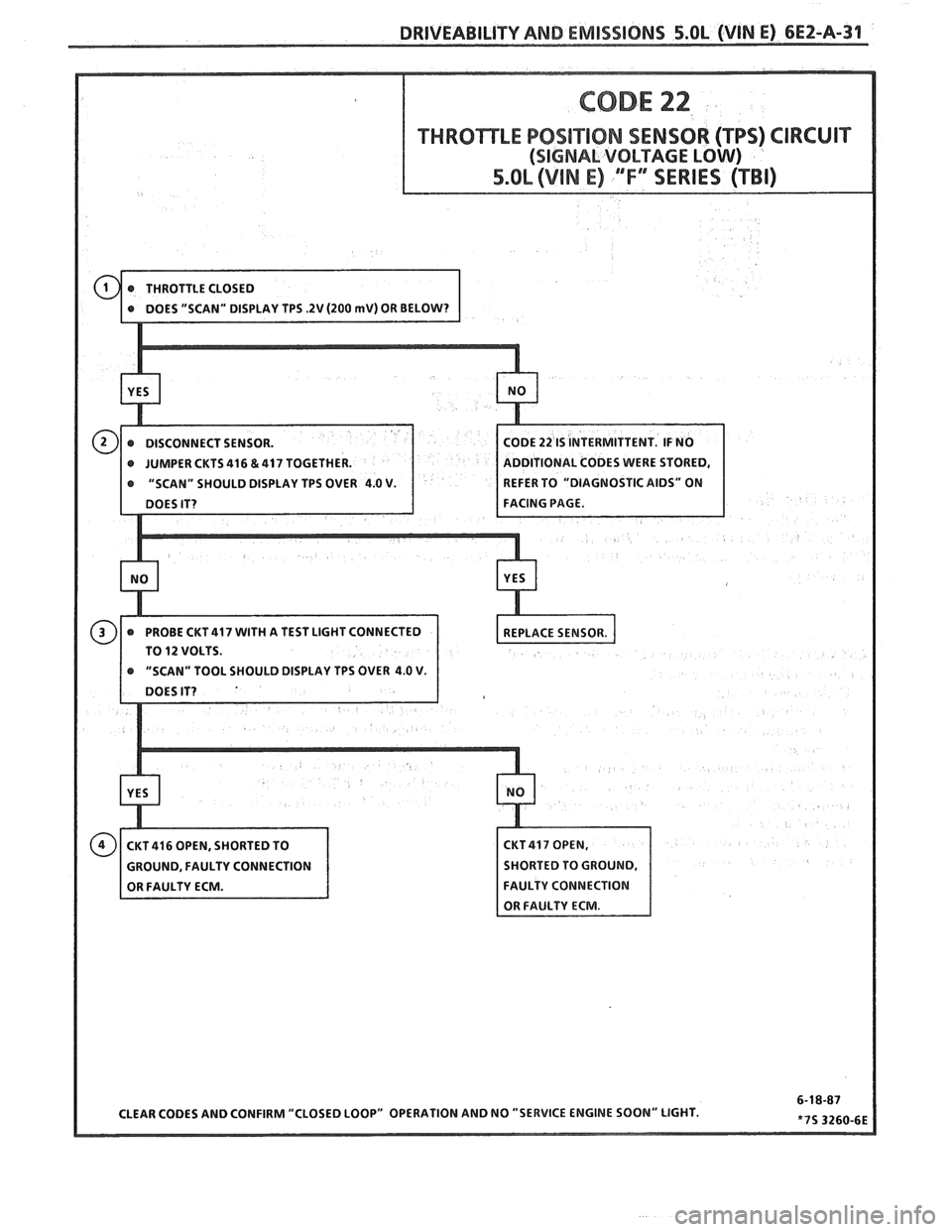
DRIVEABILITY AND EMISSIONS 5.OL (VIN E) 6EZ-A-31
THROTTLE POSITION SENSOR (TPS) CIRCUIT
ODE 22 IS INTERMITTENT. IF NO
@ JUMPER CKTS 416 & 417 TOGETHER. DDlTlONAL CODES WERE STORED,
@ "SCAN" SHOULD DISPLAY TPS OVER 4.0 V. EFER TO "DIAGNOSTIC AIDS" ON
TO
12 VOLTS.
Page 523 of 1825
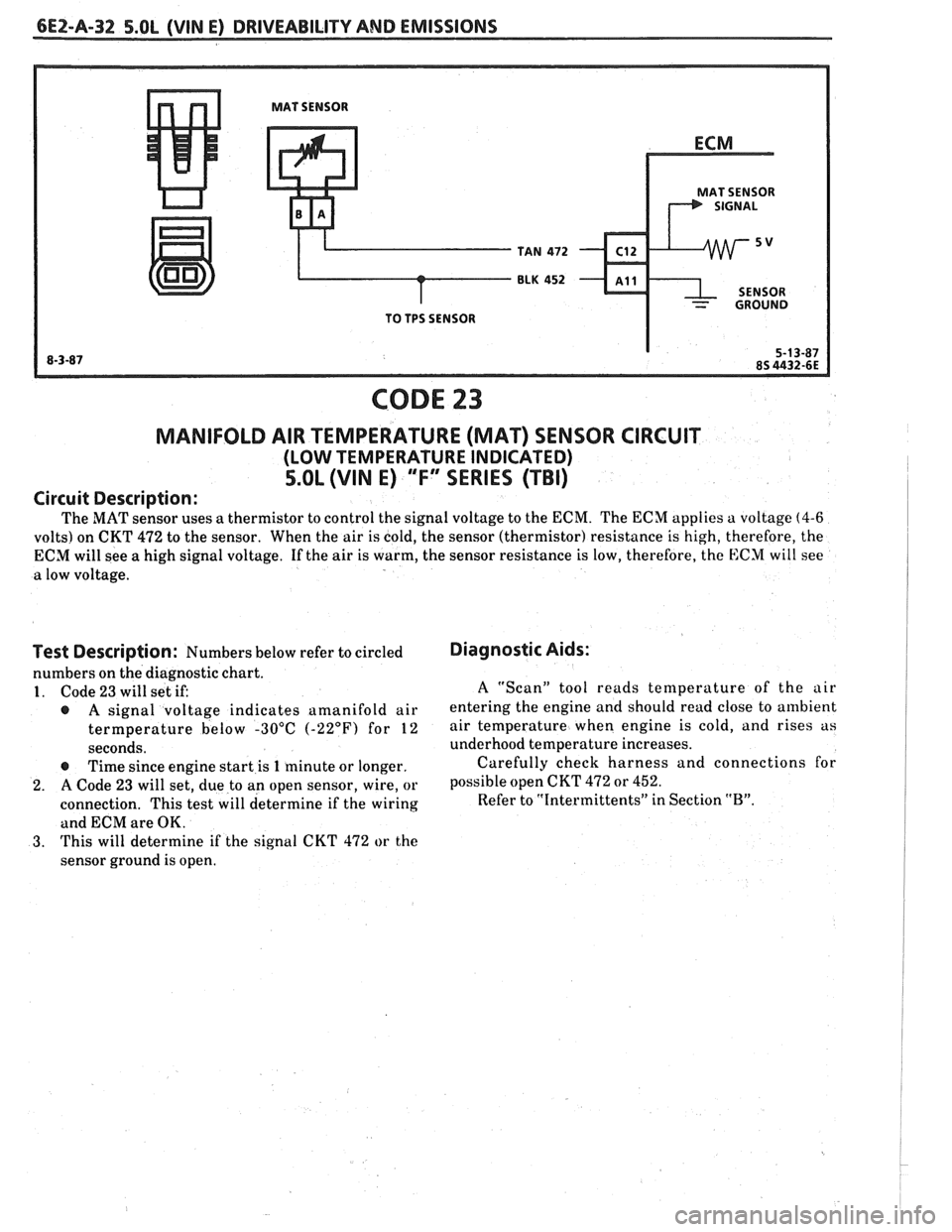
6E2-A-32 S.OL (VIN E) DRIVEABILITY AND EMISSIONS
MAT SENSOR
MAT SENSOR
TAN
472 C12
BLK 452 - ~11
- GROUND
TO TPS SENSOR
CODE 23
MANIFOLD AIR TEMPERATURE (MAT) SENSOR CIRCUIT
(LOW TEMPERATURE INDICATED)
5.OL (VIN E) "F" SERIES (TBI)
Circuit Description:
The MAT sensor uses a thermistor to control the signal voltage to the ECM. The ECM applies a voltage (4-6
volts) on CKT 472 to the sensor. When the air is cold, the sensor (thermistor) resistance is high, therefore, the
ECM will see a high signal voltage. If the air is warm, the sensor resistance is low, therefore, the
E:CM will see
a low voltage.
i
Test Description: Numbers below refer to circled
numbers on the diagnostic chart.
1. Code 23 will set if:
@ A signal voltage indicates amanifold air
termperature below -30°C
(-22°F) for 12
seconds.
@ Time since engine start is 1 minute or longer.
2. A Code 23 will set, due to an open sensor, wire, or
connection. This test will determine if the wiring
and ECM are OK.
3. This will determine if the signal CKT 472 or the
sensor ground is open.
Diagnostic Aids:
A "Scan" tool reads temperature of the air
entering the engine and should read close to ambient
air temperature when engine is cold, and rises as
underhood temperature increases.
Carefully check harness and connections for
possible open CKT
472 or 452.
Refer to "Intermittents" in Section "B".
Page 524 of 1825
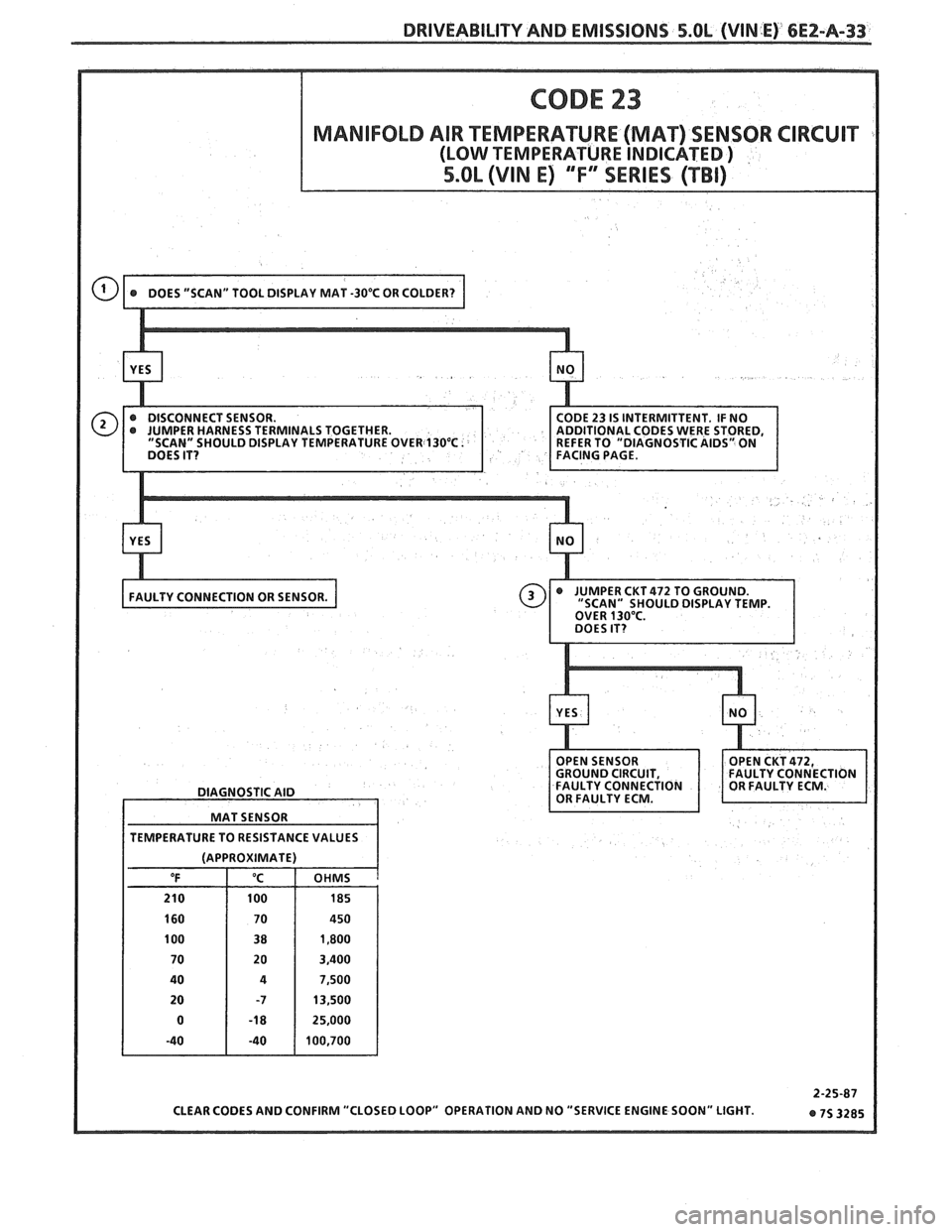
DRIVEABILITY AND EMISSIONS 5.OL (VIN E) 6E2-A-33
DIAGNOSTIC AID
MAT SENSOR
TEMPERATURE TO RESISTANCE VALUES
(APPROXIMATE) OHMS
a
Page 525 of 1825
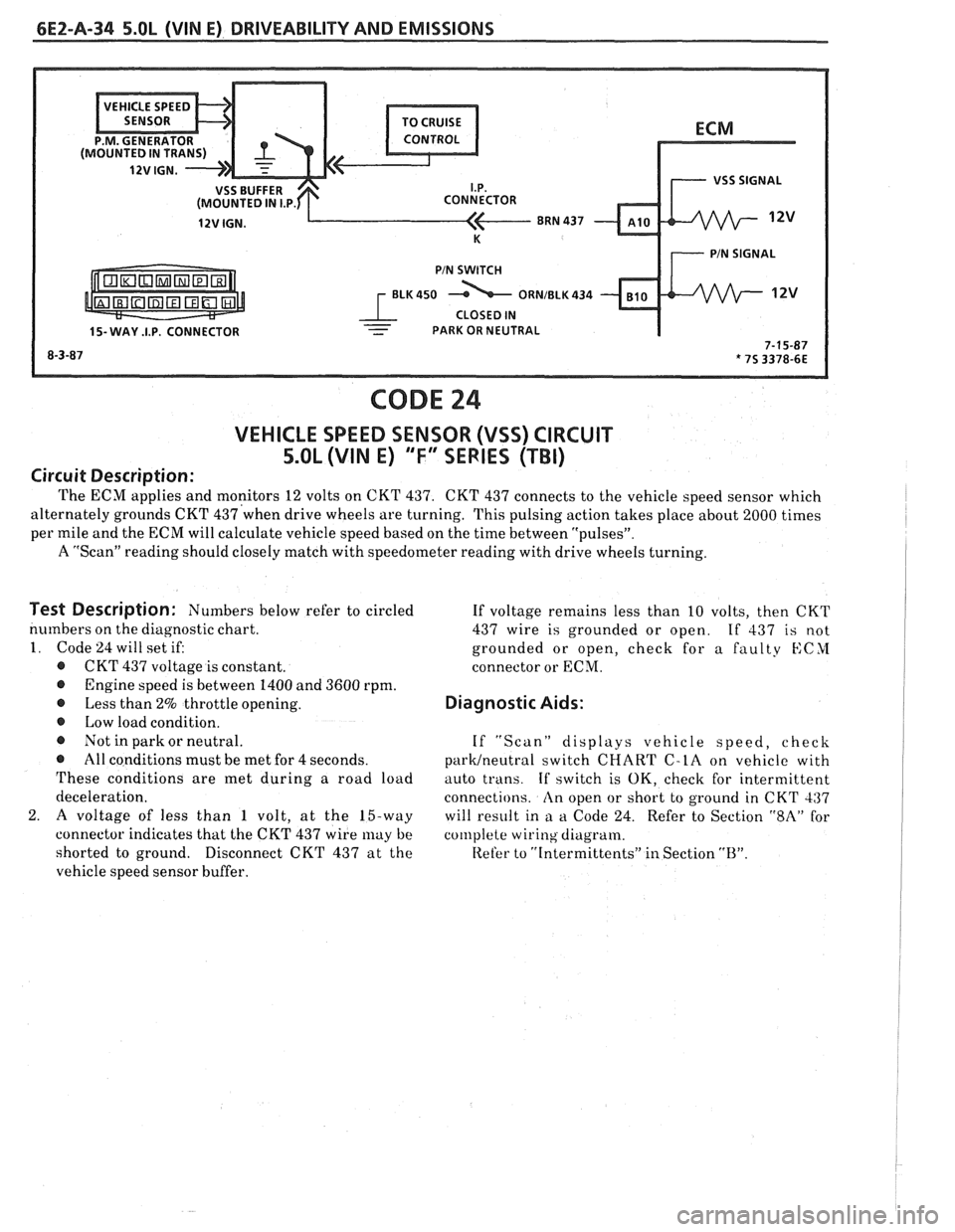
6EZ-A-34 5.OL (WIN E) DRIVEABILITY AND EMISSIONS
ECM
I.P.
8RN 437
K 7 PIN SIGNAL
PIN SWITCH
r ELK450 12v
1 CLOSED IN - 15- WAY .I.P. CONNECTOR - - PARK OR NEUTRAL I
CODE 24
VEHICLE SPEED SENSOR (VSS) CIRCUIT
5.OL (VIN E) "F" SERIES (TBI)
Circuit Description:
The ECM applies and monitors 12 volts on CKT 437. CKT 437 connects to the vehicle speed sensor which
alternately grounds CKT
437'when drive wheels are turning. This pulsing action takes place about 2000 times I
per mile and the ECM will calculate vehicle speed based on the time between "pulsesJ'.
A "Scan" reading should closely match with speedometer reading with drive wheels turning.
I
Test Description: Numbers below refer to circled
numbers on the diagnostic chart.
1. Code 24 will set if:
@ CKT 437 voltage is constant.
@ Engine speed is between 1400 and 3600 rpm.
@ Less than 2% throttle opening.
@ Low load condition.
@ Not in park or neutral.
@ All conditions must be met for 4 seconds.
These conditions are met during a road load
deceleration.
2.
A voltage of less than 1 volt, at the 15-way
connector indicates that the CKT 437 wire
may be
shorted to ground.
Disconnect CKT 437 at the
vehicle speed sensor buffer. If
voltage remains less than 10 volts, then CKT
437 wire is grounded or open.
If 437 is not
grounded or open, check for a faulty
KCYI
connector or ECM.
Diagnostic Aids:
If "Scan" displays vehicle speed, check
parWneutra1 switch CHART C-LA on vehicle with
auto trans.
If switch is OK, check for intermittent
connections.
An open or short to ground in CKT 437
will result in
a a Code 24. Refer to Section "$A" for
col~lplete wiring diagram.
Refer to
"[ntermittents" in Section "B".
Page 526 of 1825
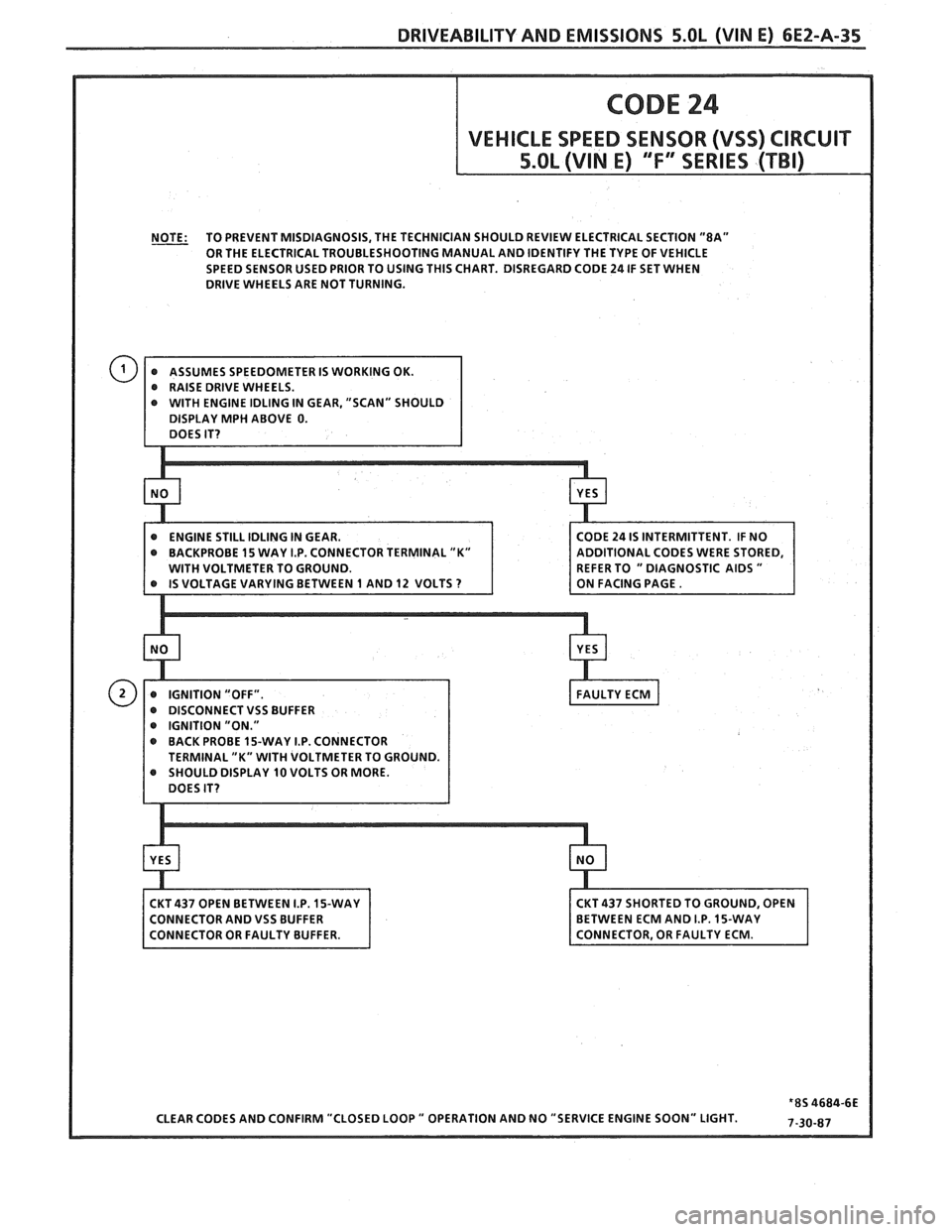
DRIVEABILITY AND EMISSIONS 5.OL (WIN E) 6E2-A-35
NOTE: TO PREVENT MISDIAGNOSIS, THE TECHNICIAN SHOULD REVIEW ELECTRICAL SECTION "8A"
OR THE ELECTRICAL TROUBLESHOOTING MANUAL AND IDENTIFY THE TYPE OF VEHICLE
SPEED SENSOR USED PRIOR TO USING THIS CHART. DISREGARD CODE
24 IF SET WHEN
DRIVE WHEELS ARE NOT TURNING.
CTOR TERMINAL "K"
e IGNITION "ON." @ BACK PROBE 15-WAY I.P. CONNECTOR
ISPLAY 10 VOLTS OR MORE.
ONNECTOR AND
VSS BUFFER
CLEAR CODES AND CONFIRM "CLOSED LOOP
" OPERATION AND NO "SERVICE ENGINE SOON" LIGHT.
Page 527 of 1825
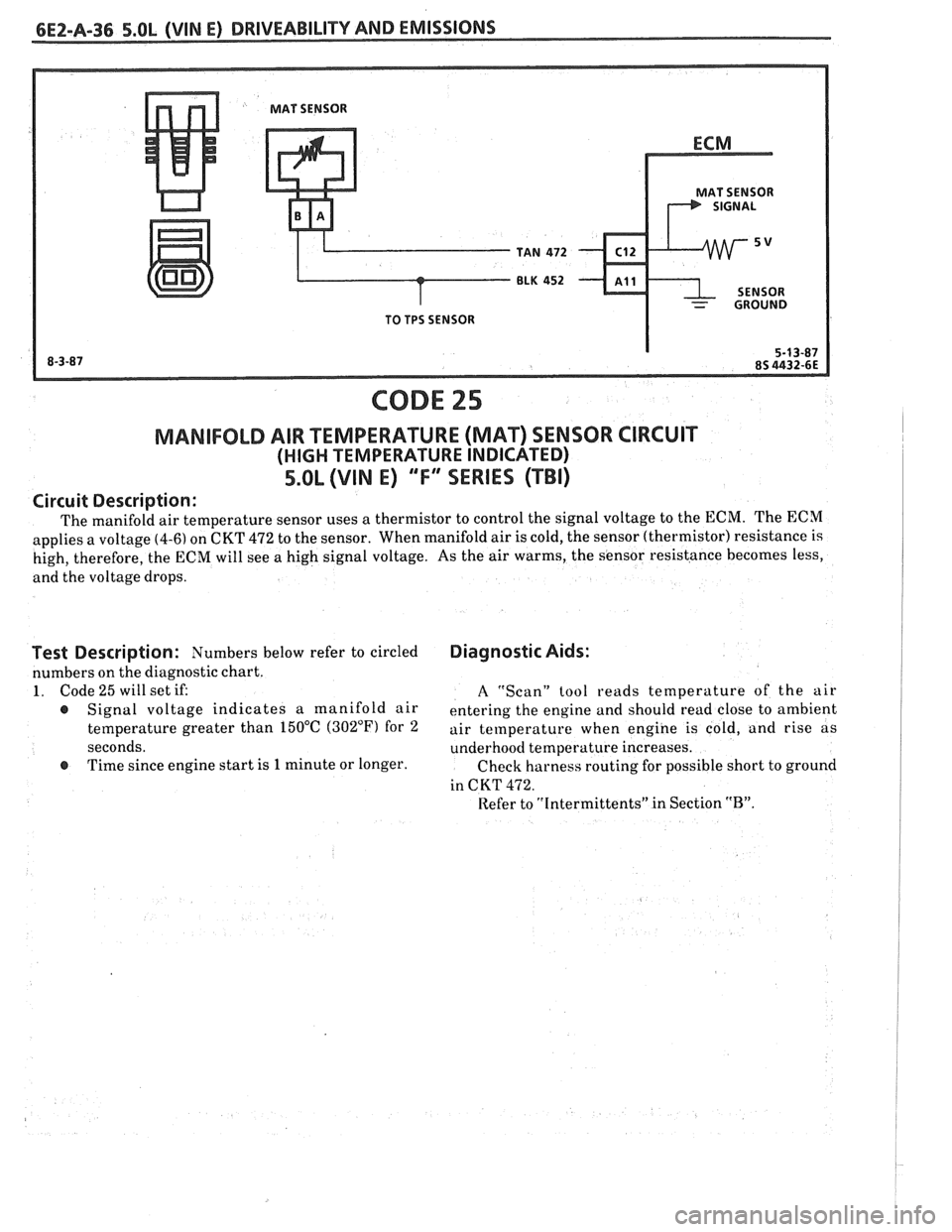
CODE 25
MANIFOLD AIR TEMPERATURE (MAn SENSOR CIRCUIT
(HIGH TEMPERATURE INDICATED)
5.OL (VIN E) ""FYOERIES (TBI)
Circuit Description:
The manifold air temperature sensor uses a thermistor to control the signal voltage to the ECM. The ECM
applies a voltage
(4-6) on CKT 472 to the sensor. When manifold air is cold, the sensor (thermistor) resistance is
high, therefore, the ECM will see a high signal voltage. As the air warms, the sensor resistance hecomes less,
and the voltage drops.
Test Description: Numbers below refer to circled
numbers on the diagnostic chart.
1. Code 25 will set if:
@ Signal voltage indicates a manifold air
tetnperature greater than 150°C
(302"F) for 2
seconds.
@ Time since engine start is 1 minute or longer.
Diagnostic Aids:
A "Scan" tool reads temperature of the air
entering the engine and should read close to ambient
air tetnperature when engine is cold, and rise as
underhood temperature increases.
Check harness routing for possible short to ground
in C KT
472.
Refer to "Intermittents" in Section "B".
Page 528 of 1825
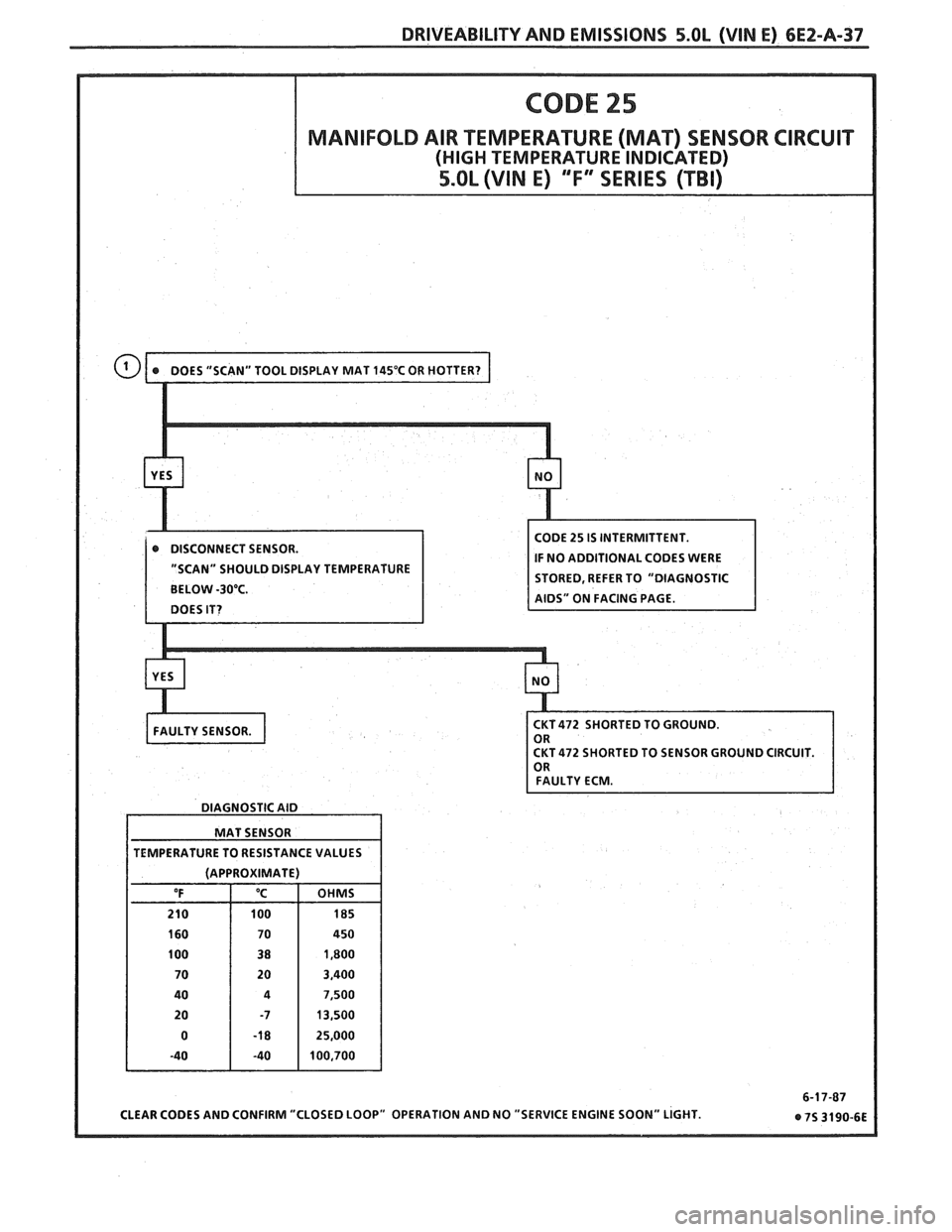
DRIVEABILITY AND EMISSIONS 5.OL (VIN E) 6EZ-A-37
LAY TEMPERATURE
CKT472 SHORTED TO GROUND.
CKT 472 SHORTED TO SENSOR GROUND CIRCUIT.
DIAGNOSTIC AID
MAT SENSOR
TEMPERATURE TO RESISTANCE VALUES (APPROXIMATE)
Page 529 of 1825
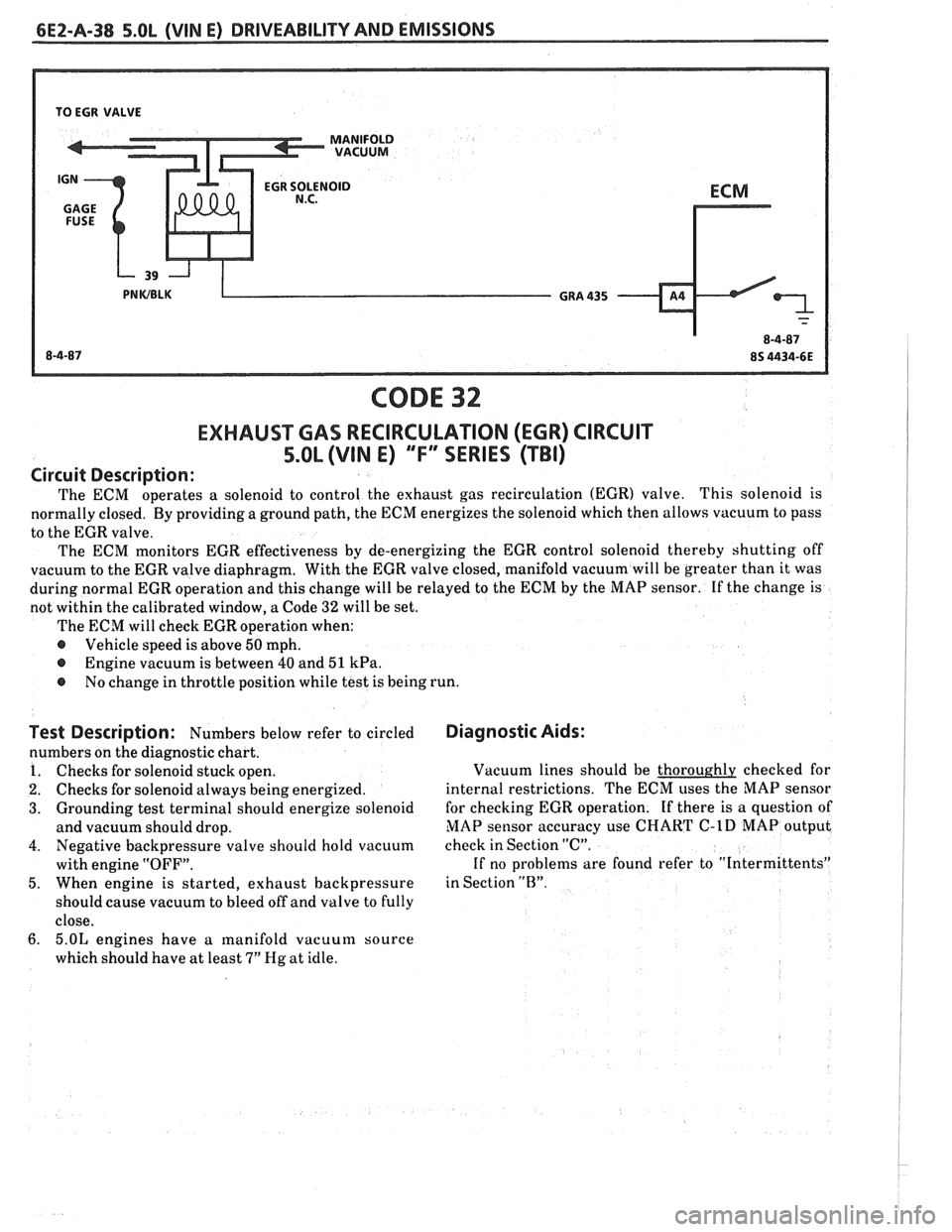
6EZ-A-38 5.OL (VIN E) DRIVEABILITY AND EMISSIONS
TO EGR VALVE
CODE 32
EXHAUSWAS RECIRCULATION (EGR) CIRCUIT
5.OL (VIN E) "FF" SERIES (TBI)
Circuit Description:
The ECM operates a solenoid to
control the exhaust gas recirculation (EGR) valve. This solenoid is
normally closed. By providing a ground path, the ECM energizes the solenoid which then allows vacuum to pass
to the EGR valve.
The ECM monitors EGR effectiveness by de-energizing the EGR control solenoid thereby shutting off
vacuum to the EGR valve diaphragm. With the EGR valve closed, manifold vacuum will be greater than it was
during normal EGR operation and this change will be relayed to the ECM by the MAP sensor. If the change is
not within the calibrated window, a Code
32 will be set.
The ECM will check EGR operation when:
@ Vehicle speed is above 50 mph.
@ Engine vacuum is between 40 and 51 kPa.
@ No change in throttle position while test is being run.
Test Description: Numbers below refer to circled
numbers on the diagnostic chart.
1. Checks for solenoid stuck open.
2. Checks for solenoid always being energized.
3. Grounding test terminal should energize solenoid
and vacuum should drop.
4. Negative backpressure valve should hold vacuum
with engine "OFF".
5. When engine is started, exhaust backpressure
should cause vacuum to bleed off and valve to fully
close.
6. 5.OL engines have a ~nanifold vacuum source
which should have at least
7" Hg at idle.
Diagnostic Aids:
Vacuum lines should be thoroughly checked for
internal restrictions. The ECM uses the MAP sensor
for checking EGR operation. If there is a question of
MAP sensor accuracy use
CHART C-1D MAP output
check in Section "C".
If no problems are found refer to "Intermittents"
in Section
"13".
Page 530 of 1825
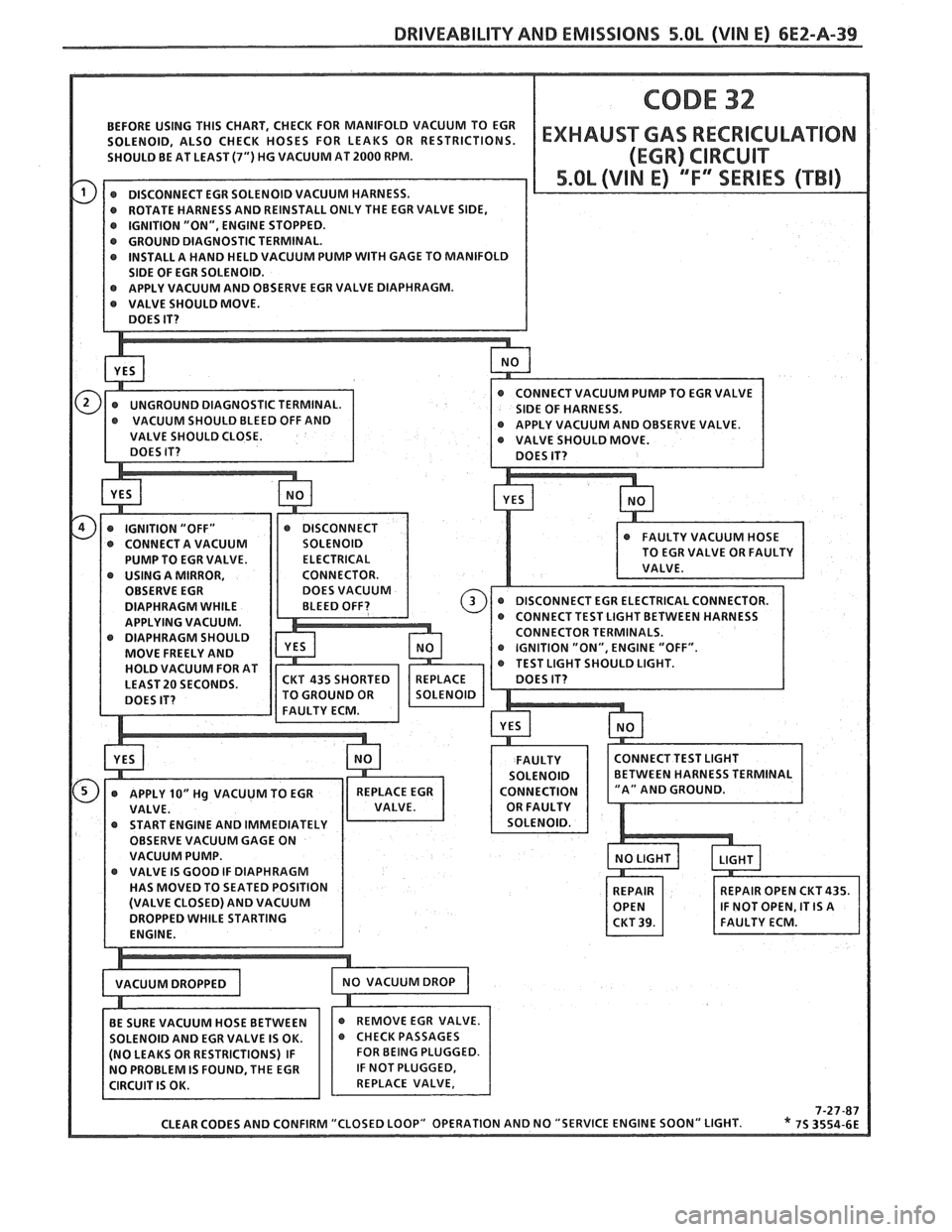
DRIVEABILITY AND EMISSIONS 5.OL (VIN E) 6EZ-A-39
BEFORE USING THIS CHART, CHECK FOR MANIFOLD VACUUM TO EGR
@ GROUND DIAGNOSTIC TERMINAL. @ INSTALL A HAND HELD VACUUM PUMP WITH GAGE TO MANIFOLD
PUMP TO EGR VALVE.
@ USING A MIRROR,
OBSERVE EGR
DIAPHRAGM WHILE
APPLYING VACUUM.
DIAPHRAGM SHOULD OR
TERMINALS.
MOVE FREELY AND "ON",
ENGINE "OFF".
HOLD VACUUM FOR AT T
SHOULD LIGHT.
LEAST
20 SECONDS.
OBSERVE VACUUM GAGE ON
VACUUM PUMP.
HAS MOVED TO SEATED POSITION
CLEAR CODES AND CONFIRM "CLOSED LOOP"
OP